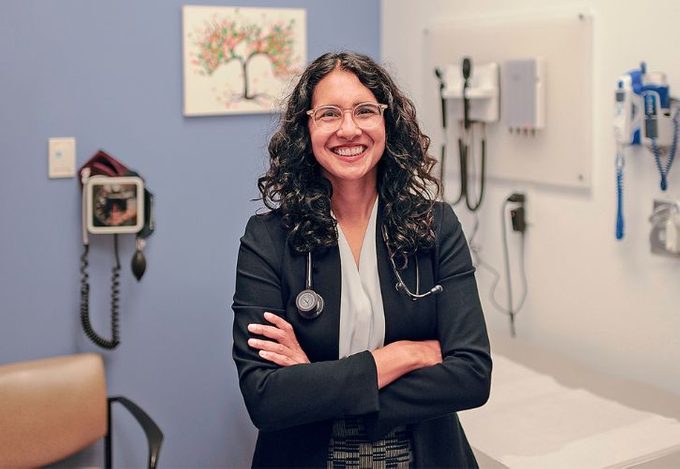Why Is There a Shortage of Family Doctors in Canada?

Over one in five Canadians don't have a primary care provider.
Primary care, Tara Kiran likes to say, is the front door to the health-care system. It’s the first place we turn to when there’s an issue, and it helps coordinate our entry into other parts of the system, whether that’s organizing diagnostic tests or surgical procedures or specialized care. Family doctors like Kiran, who is a physician at St. Michael’s Hospital and Unity Health and the Fidani Chair of Improvement and Innovation at the University of Toronto, can see patients over decades, leaning on this long relationship to manage their physical and mental health and keep them well.

But for an alarming number of Canadians, health care’s front door has slammed shut. A large national survey conducted by Kiran and her research team found that 22 percent of us don’t have access to a family doctor or nurse practitioner, which works out to more than 6.5 million adults. Some provinces are in particularly bad shape right now: 27 percent of people in B.C. and 31 percent of those in Quebec and Atlantic Canada go without primary care. Other provinces will soon see the doctor shortage worsen: A recent study in Ontario found that 65 percent of family physicians plan to reduce their hours or leave the profession altogether in the next five years.
So far, there’s been a lot of hand-wringing and not a lot of action. But, last year, Kiran launched OurCare, a national public initiative to shape the blueprint for stronger, more equitable primary care. “All too often, whenever clinicians, professional organizations and policymakers talk about reform, the people missing from the table are the patients,” she says. “Patients should co-design the future of primary care.” Kiran is holding community roundtables and panels in five provinces, and their recommendations will anchor reports presented to health ministers and policymakers across the country. Here, she discusses how we got into this mess, which approaches can lead us out of it and why family doctors don’t get the respect they deserve.
What happens when you can’t find a family doctor?
“It has a huge impact. It means you’re often not getting the care you should to keep you well. You might be missing out on screening or immunizations, and you may struggle to minimize the impact of chronic conditions, whether that’s pain or diabetes or hypertension. You also have difficulty accessing care when you’re really sick, and you turn to places that I would say are poor substitutes. Walk-in clinics don’t do preventative care. Emergency departments are made for emergencies, not chronic conditions. But also, those systems are already struggling, and when there aren’t family doctors who can take care of people in the community, hospitals become even more overwhelmed.
Who’s less likely to have a primary care provider?
Additionally, certain groups are less likely to have a family doctor or nurse practitioner, and those include people who are new to Canada, people who are racialized and people who live in low-income neighbourhoods. There are rural and remote areas that have specific challenges as well, and barriers to access aren’t the same across the provinces. We have an Indigenous population that faces continued discrimination and racism within the system, and all sorts of barriers to care. So that’s all to say that the crisis really is a crisis.”
How did we get here?
“We’ve under-invested in primary care for decades, and we have an archaic system designed for the way medicine was practiced and the kind of health issues we had maybe 50 years ago. But people are living longer, there are far more medications, more people have many more diagnoses—you’re no longer coming into the doctor’s office with one issue that can be treated with an antibiotic. We’re stuck in a system where family doctors are paid by the visit, and often working on their own. And we have human resource challenges in primary care. More and more doctors are retiring. In the first six months of the pandemic, for example, twice as many family doctors stopped working as we expected, given the trends from the previous decade. And there are fewer and fewer people who’ve graduated medical school wanting to become family doctors.”
Why don’t med students go into primary care?
“One of the major reasons is respect. People still hear the narrative of: “Oh, you just want to be a family doctor?” Just. Respect can manifest through the amount we are paid, and family medicine is certainly not among the highest remunerative specialties. Also, family doctors run their own small business. So if you want to go on vacation, or go on parental leave, you have to find your own replacement and figure out how you’re going to pay your employees and pay the rent while you’re away. You can’t leave that to someone else.”
The pandemic couldn’t have helped, either.
“It was a challenging time for family doctors. They didn’t get priority access to personal protective equipment and actually often had to buy it themselves. They also had to arrange for infection protection control practices and stay up to date on what those practices should be. At the same time, that they were losing money, because they’re paid by the visit and people weren’t meant to come in unless their cases were really acute. Then, in addition to COVID, we saw a rise in mental health issues and addictions, a backlog of deferred care, long wait times to get surgery or diagnostic tests and difficulty in accessing specialists. In my own primary care practice, it’s not uncommon for me to open my inbox and see a whole slew of declined referrals. Patients are definitely suffering, and family doctors are struggling to support them. That can feel really hard and bad every day.”
I can see why it would be tempting to move to a walk-in clinic or take a different job—or just leave the public system entirely, which is what’s happening in Quebec, right?
“Unfortunately, more and more doctors in Quebec are gravitating toward the private pay system. So they’re leaving the public system, where they would get paid through billing the government, and instead are billing patients directly for care that should be covered by Medicare. That’s making the family doctor shortage even worse, and patients are so desperate that they end up paying, because it’s the only option they see.”
How do we reverse these trends in primary care?
“We know that there are not enough doctors and nurse practitioners to serve everyone. Even with increases in medical school and nursing enrolments, we’re not going to square the circle. So the only way we can offer everybody access to primary care is by changing the way we work. A single doctor can’t do everything. But if we take a team-based approach, it can expand the capacity of doctors to support a large roster of patients. Ideally a family doctor will work with nurse practitioners, social workers, pharmacists, physiotherapists or psychologists. Maybe they’re integrating virtual care into their team as well, as a way of extending care for folks who are marginalized, rural or have other barriers to access. Not everything falls to a doctor, and if a doctor leaves, patients still have a place of care. And we know that when everyone has access to primary care, mortality rates go down and life expectancy goes up.”
What have patients been telling you during the OurCare panels?
“Despite the diversity of voices, there are a lot of common values: equity, accessibility, having transparency in the system, having it people-centred and preventative-focused. Peopled also talked about having the team responsible for a geographic catchment, similar to how a public school is meant to serve all the kids in the neighbourhood. Every kid has guaranteed access to education. Similarly, we want every person in the neighbourhood to have guaranteed access to primary care. Team-based care sounds like what a lot of us do out of necessity—cobbling together a number of different providers on our own—only more formalized and far less stressful. I think so. And it’s not just about doctor care. We’ve heard from people around the country who have recommended that dental care and eye care and medications and mental-health treatment could all be included as well. There’s a real consensus that we need to scale up team-based care.”
Well, I’m sold —and so is the Canadian Medical Association, which cited expanding team-based care as a top solution to the health-care crisis. So how does that happen?
“Governments need to commit the money. On average, Canada spends a lot less on primary care than comparative OECD countries do—5.3 percent of our total health budget, as opposed to 8.1 percent across the OECD countries. We need the investment and the political will to make it happen. But we also need the professional groups to be fully on board. Working in a team will involve some trade offs for doctors. This might mean a bit less autonomy, or more accountability, in exchange for more support. But medicine is harder and harder to practice, and it’s really helpful to have people around you to share the load.”
And there’s no chance of sharing the load with an AI doctor anytime soon?
“Oh, no, our information system is not very smart at all. I feel that every day when I’m printing out pages from medical records to then fax them so they can be scanned in. It’s nuts. Just having electronic medical records that patients and doctors all can access would be a start.”
Next: Why Doctors Should Be Versed in Linguistics and Sociology




